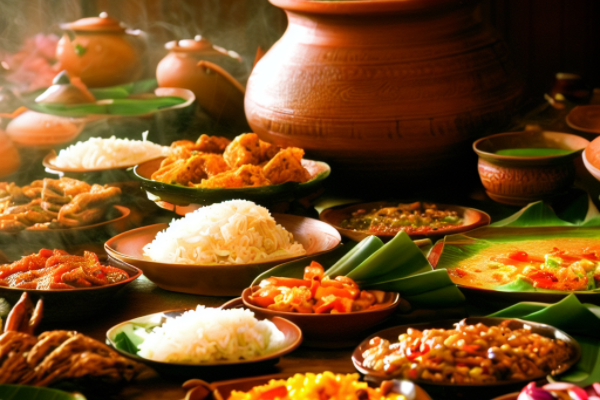Sri Lankan food culture – By Malsha – eLanka

Sri Lankan food culture is rich and diverse, influenced by its history, geography, and the different communities that call the island nation home. Sri Lanka, located in South Asia, has a unique culinary tradition that incorporates a variety of flavors, spices, and ingredients. The food culture in Sri Lanka is characterized by its vibrant colors, aromatic spices, and a blend of indigenous, colonial, and foreign influences.
- Rice and Curry: Rice is the staple food of Sri Lanka, and a traditional meal is often centered around rice and a variety of curries. A typical Sri Lankan meal consists of steamed rice served with several different curries made from vegetables, meat, or fish. The curries are usually cooked with coconut milk and a blend of spices, such as cinnamon, cardamom, cloves, and curry leaves.
- Coconut: Coconut plays a significant role in Sri Lankan cuisine. Coconut milk, grated coconut, and coconut oil are commonly used in various dishes, providing a creamy texture and enhancing the flavor.
- Spices: Sri Lanka is renowned for its spices, and they are an essential part of the country’s food culture. Cinnamon, cardamom, cloves, nutmeg, and pepper are among the commonly used spices in Sri Lankan cooking. The use of these spices gives the food its distinct aroma and taste.
- Seafood: As an island nation surrounded by the Indian Ocean, Sri Lanka has a wide range of seafood options. Fish, prawns, crab, and squid are commonly used in various dishes.
- Hoppers and String Hoppers: Hoppers (appa) are bowl-shaped pancakes made from rice flour and coconut milk. They are often eaten for breakfast or as a snack, accompanied by a spicy sambal or curry. String hoppers (idiyappam) are another popular breakfast dish made from rice noodles, usually served with coconut milk and jaggery.
- Kottu Roti: Kottu Roti is a famous street food in Sri Lanka. It is made by stir-frying shredded godhamba roti (a type of flatbread) with vegetables, eggs, and a choice of meat or fish. The sound of the vendors chopping the ingredients on a hot griddle is a familiar one in the streets of Sri Lanka.
- Sambols and Chutneys: Sambols and chutneys are common accompaniments to Sri Lankan meals. They are made from various ingredients like coconut, chili, onion, lime, and sometimes Maldive fish. These condiments add extra layers of flavor and spice to the meal.
- Sweets and Desserts: Sri Lanka has a variety of traditional sweets and desserts, often prepared for special occasions and festivals. Some popular sweets include kavum, kokis, pani walalu, and kiribath (milk rice).
- Cultural Influences: Sri Lankan food culture is shaped by the country’s multi-ethnic population. Different regions and communities have their unique culinary traditions. For example, the Sinhalese, Tamil, and Muslim communities have their distinct dishes and preparation methods.
- Traditional Food Customs: In Sri Lankan culture, it is customary to eat with your right hand, as the left hand is considered unclean. Sharing food is a common practice in Sri Lanka, and hospitality is highly valued.
Sri Lankan food culture is a delightful blend of flavors, textures, and aromas, reflecting the island’s rich history and diverse heritage. Visitors to Sri Lanka can explore and savor this unique culinary experience through a wide range of traditional dishes available throughout the country.







